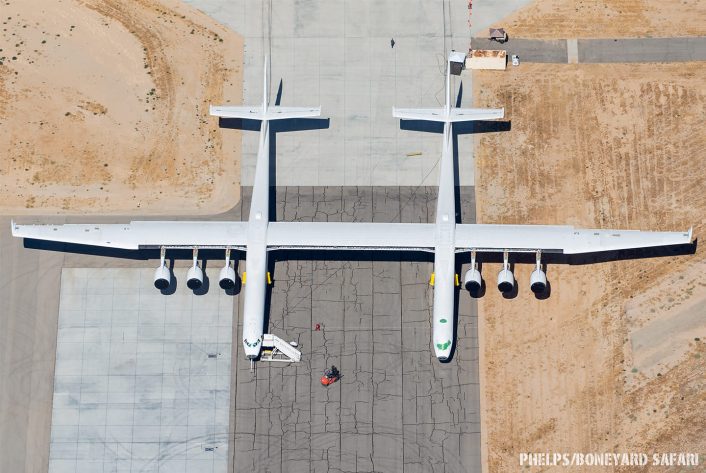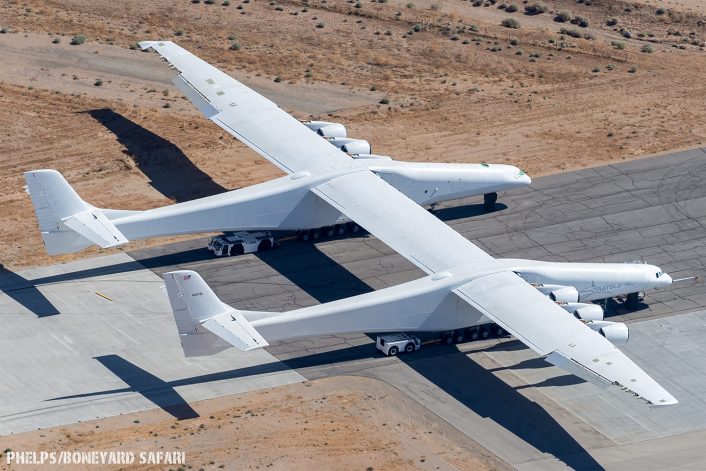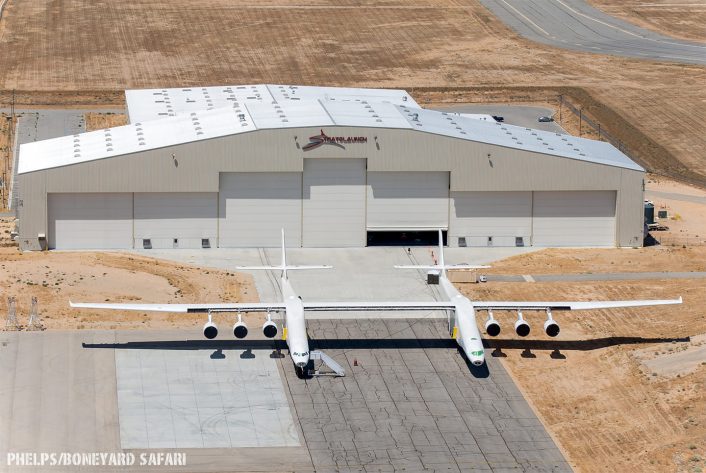These photographs show the current status of the massive aircraft as it waits to resume flying activity at the Mojave Air & Space Port in California.
The world’s largest aircraft, the Stratolaunch Launch Systems Stratolaunch Aircraft Carrier, flew for the first time on April 13, 2019. Flown by Scaled Composites experimental test pilot Evan Thomas, a 28-year veteran of the U.S. Air Force, F-16 pilot and former Vice Wing Commander of the 46th Test Wing, the gigantic aircraft took off from the Mojave Air & Space Port in California at 06:58 Pacific Daylight Time and conducted an initial test flight that lasted 2.5 hours achieving a maximum altitude of 17,000 feet and a top speed of 189 MPH before landing.
Although the first flight went well, that was the only time the aircraft took to the air.
Reports that Stratolaunch was closing started surfacing online on Friday, May, 31, 2019, few weeks after the historic first flight.
The Stratolaunch aircraft was intended to carry spacecraft to altitude where they would be dropped and then fly into orbit under their own power. The Stratolaunch can carry a payload of up to 500,000 pounds or 250 tons according to Stratolaunch Launch Systems. The gigantic Stratolaunch has the largest wingspan in the world at 117.3 meters (384.8 feet), significantly larger than the previous record holder, the Antonov An-225 “Mriya” heavy lift cargo aircraft. The Stratolaunch is powered by six enormous Pratt & Whitney PW4000 jet engines formerly used on the Boeing 747 that only used four engines.

While the approach to commercial space flight was novel, competition by other commercial, reusable spacecraft launch operations like Elon Musk’s SpaceX offered more conventional and likely more practical solutions to boost payloads into orbit.
Stratolaunch was founded in 2011 under parent corporation Vulcan, Inc. Both Paul Allen and CEO Jean Floyd ran the company until Allen’s death in October, 2018. The company ceased operations in May 2019 and placed all company assets, including the Stratolaunch Carrier aircraft, for sale for US$400 million by June 2019. Cerberus Capital Management acquired Stratolaunch Systems including the aircraft in October 2019 and, in December the same year, Stratolaunch announced that it would focus on offering high-speed flight test services.
In 2020, the company under new management unveiled the Talon-A (a rebranded version of the previous hypersonic vehicle dubbed Hyper-A). According to Stratolaunch, Talon-A is a fully reusable, autonomous, liquid rocket-powered Mach 6-class hypersonic vehicle with a length of 28 feet (8.5 m), wingspan of 11.3 feet (3.4 m), and a launch weight of approximately 6,000 pounds (2,722 Kg). The Talon-A will conduct over 1-minute of hypersonic flight testing, and glide back for an autonomous, horizontal landing on a conventional runway. The vehicle will also be capable of autonomous take-off, under its own power, via a conventional runway. The company also said it would develop a larger hypersonic vehicle once known as Hyper-Z, and now called Talon-Z, plus a space plane nicknamed Black Ice, “a fully reusable space plane that enables advanced on-orbit capabilities and cargo return. Initial designs optimized for cargo launch, with a follow-on variant capable of transporting crew.” Both vehicles will be air-launched by the Stratolaunch Carrier that, according to the datasheet, should be able to support operational aicraft services by 2022.
While it waits to resume flight testing, the massive aircraft was photographed from the air at its base in Mojave. On Jul. 24, 2020, Boneyard Safari‘s Dylan Phelps was out for a photoshoot of the final landing of a Qantas 747 being retired, when he spotted that the Stratolaunch Carrier Aircraft had been rolled out into the California.

The photographs Dylan has sent us show the current status of the aircraft. It looks like some work is required to make the big bird airworthy again: for instance, based on the photos, the whole leading edge slat along with the nose cones and the outer ailerons have been removed, probably as part of the long-term storage procedures.










